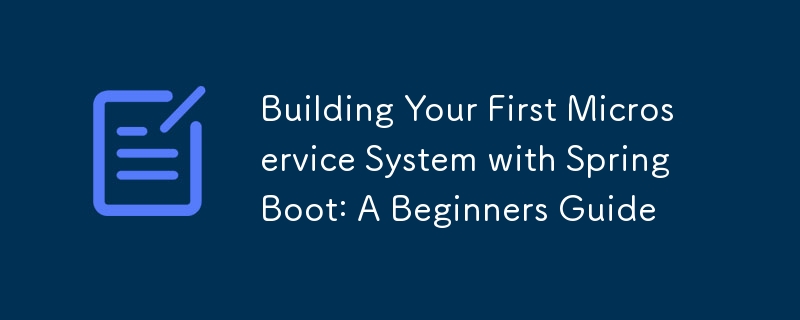

Dans ce guide, nous expliquerons la création d'un système de microservices simple mais complet à l'aide de Spring Boot. Nous couvrirons les bases des microservices, la configuration de l'environnement requis et la mise en œuvre de deux microservices : OrderService et InventoryService. De plus, nous intégrerons la découverte de services à l'aide d'Eureka et d'une passerelle API pour gérer le routage entre les services.
Les microservices sont un style d'architecture logicielle dans lequel une application est construite comme un ensemble de petits services indépendants qui fonctionnent ensemble. Chaque service est autonome et communique avec les autres via des API bien définies, rendant le système plus flexible, évolutif et plus facile à gérer.
L'architecture de notre système sera composée de deux microservices : OrderService et InventoryService. Le OrderService utilisera une base de données relationnelle (MySQL) pour stocker les détails de la commande, tandis que l'InventoryService utilisera une base de données NoSQL (MongoDB) pour gérer les données d'inventaire. Nous mettrons également en œuvre la découverte de services avec Eureka et utiliserons une passerelle API pour le routage des requêtes.
Avant de commencer, assurez-vous que les outils suivants sont installés :
Ouvrez le fichier application.properties dans src/main/resources et ajoutez la configuration suivante :
spring.datasource.url=jdbc:mysql://localhost:3306/orderservice spring.datasource.username=root spring.datasource.password=yourpassword spring.datasource.driver-class-name=com.mysql.cj.jdbc.Driver spring.jpa.hibernate.ddl-auto=update spring.jpa.show-sql=true spring.jpa.properties.hibernate.dialect=org.hibernate.dialect.MySQL8Dialect server.port=8081
Créez la classe d'entité Order dans src/main/java/com/ordersystem/orderservice/model/Order.java :
package com.ordersystem.orderservice.model;
import lombok.AllArgsConstructor;
import lombok.Data;
import lombok.NoArgsConstructor;
import javax.persistence.*;
@Data
@AllArgsConstructor
@NoArgsConstructor
@Entity
@Table(name = "orders")
public class Order {
@Id
@GeneratedValue(strategy = GenerationType.IDENTITY)
private Long id;
private String product;
private int quantity;
private double price;
}
Créez l'interface OrderRepository dans src/main/java/com/ordersystem/orderservice/repository/OrderRepository.java :
package com.ordersystem.orderservice.repository;
import com.ordersystem.orderservice.model.Order;
import org.springframework.data.jpa.repository.JpaRepository;
public interface OrderRepository extends JpaRepository<Order, Long> {
}
Créez la classe OrderService dans src/main/java/com/ordersystem/orderservice/service/OrderService.java :
package com.ordersystem.orderservice.service;
import com.ordersystem.orderservice.model.Order;
import com.ordersystem.orderservice.repository.OrderRepository;
import org.springframework.beans.factory.annotation.Autowired;
import org.springframework.stereotype.Service;
import java.util.List;
@Service
public class OrderService {
@Autowired
private OrderRepository orderRepository;
public List<Order> getAllOrders() {
return orderRepository.findAll();
}
public Order getOrderById(Long id) {
return orderRepository.findById(id).orElse(null);
}
public Order createOrder(Order order) {
return orderRepository.save(order);
}
public void deleteOrder(Long id) {
orderRepository.deleteById(id);
}
}
Créez la classe OrderController dans src/main/java/com/ordersystem/orderservice/controller/OrderController.java :
package com.ordersystem.orderservice.controller;
import com.ordersystem.orderservice.model.Order;
import com.ordersystem.orderservice.service.OrderService;
import org.springframework.beans.factory.annotation.Autowired;
import org.springframework.web.bind.annotation.*;
import java.util.List;
@RestController
@RequestMapping("/api/orders")
public class OrderController {
@Autowired
private OrderService orderService;
@GetMapping
public List<Order> getAllOrders() {
return orderService.getAllOrders();
}
@GetMapping("/{id}")
public Order getOrderById(@PathVariable Long id) {
return orderService.getOrderById(id);
}
@PostMapping
public Order createOrder(@RequestBody Order order) {
return orderService.createOrder(order);
}
@DeleteMapping("/{id}")
public void deleteOrder(@PathVariable Long id) {
orderService.deleteOrder(id);
}
}
Ouvrez le fichier application.properties dans src/main/resources et ajoutez la configuration suivante :
spring.data.mongodb.uri=mongodb://localhost:27017/inventoryservice server.port=8082
Créez la classe d'entité InventoryItem dans src/main/java/com/ordersystem/inventoryservice/model/InventoryItem.java :
package com.ordersystem.inventoryservice.model;
import lombok.AllArgsConstructor;
import lombok.Data;
import lombok.NoArgsConstructor;
import org.springframework.data.annotation.Id;
import org.springframework.data.mongodb.core.mapping.Document;
@Data
@AllArgsConstructor
@NoArgsConstructor
@Document(collection = "inventory")
public class InventoryItem {
@Id
private String id;
private String product;
private int quantity;
}
Créez l'interface InventoryRepository dans src/main/java/com/ordersystem/inventoryservice/repository/InventoryRepository.java :
package com.ordersystem.inventoryservice.repository;
import com.ordersystem.inventoryservice.model.InventoryItem;
import org.springframework.data.mongodb.repository.MongoRepository;
public interface InventoryRepository extends MongoRepository<InventoryItem, String> {
}
Create the InventoryService class in src/main/java/com/ordersystem/inventoryservice/service/InventoryService.java:
package com.ordersystem.inventoryservice.service;
import com.ordersystem.inventoryservice.model.InventoryItem;
import com.ordersystem.inventoryservice.repository.InventoryRepository;
import org.springframework.beans.factory.annotation.Autowired;
import org.springframework.stereotype.Service;
import java.util.List;
@Service
public class InventoryService {
@Autowired
private InventoryRepository inventoryRepository;
public List<InventoryItem> getAllItems() {
return inventoryRepository.findAll();
}
public InventoryItem getItemById(String id) {
return inventoryRepository.findById(id).orElse(null);
}
public InventoryItem createItem(InventoryItem item) {
return inventoryRepository.save(item);
}
public void deleteItem(String id) {
inventoryRepository.deleteById(id);
}
}
Create the InventoryController class in src/main/java/com/ordersystem/inventoryservice/controller/InventoryController.java:
package com.ordersystem.inventoryservice.controller;
import com.ordersystem.inventoryservice.model.InventoryItem;
import com.ordersystem.inventoryservice.service.InventoryService;
import org.springframework.beans.factory.annotation.Autowired;
import org.springframework.web.bind.annotation.*;
import java.util.List;
@RestController
@RequestMapping("/api/inventory")
public class InventoryController {
@Autowired
private InventoryService inventoryService;
@GetMapping
public List<InventoryItem> getAllItems() {
return inventoryService.getAllItems();
}
@GetMapping("/{id}")
public InventoryItem getItemById(@PathVariable String id) {
return inventoryService.getItemById(id);
}
@PostMapping
public InventoryItem createItem(@RequestBody InventoryItem item) {
return inventoryService.createItem(item);
}
@DeleteMapping("/{id}")
public void deleteItem(@PathVariable String id) {
inventoryService.delete
Item(id);
}
}
Open the application.properties file in src/main/resources and add the following configuration:
server.port=8761 eureka.client.register-with-eureka=false eureka.client.fetch-registry=false
Annotate the main application class in src/main/java/com/ordersystem/eurekaserver/EurekaServerApplication.java with @EnableEurekaServer:
package com.ordersystem.eurekaserver;
import org.springframework.boot.SpringApplication;
import org.springframework.boot.autoconfigure.SpringBootApplication;
import org.springframework.cloud.netflix.eureka.server.EnableEurekaServer;
@SpringBootApplication
@EnableEurekaServer
public class EurekaServerApplication {
public static void main(String[] args) {
SpringApplication.run(EurekaServerApplication.class, args);
}
}
Add the Eureka client dependency to both OrderService and InventoryService:
<dependency>
<groupId>org.springframework.cloud</groupId>
<artifactId>spring-cloud-starter-netflix-eureka-client</artifactId>
</dependency>
Add Eureka client configuration to the application.properties files:
eureka.client.service-url.defaultZone=http://localhost:8761/eureka/ spring.application.name=order-service
eureka.client.service-url.defaultZone=http://localhost:8761/eureka/ spring.application.name=inventory-service
Open the application.yml file in src/main/resources and add the following configuration:
server:
port: 8080
spring:
application:
name: api-gateway
cloud:
gateway:
routes:
- id: order-service
uri: lb://order-service
predicates:
- Path=/api/orders/**
- id: inventory-service
uri: lb://inventory-service
predicates:
- Path=/api/inventory/**
eureka:
client:
service-url:
defaultZone: http://localhost:8761/eureka/
Annotate the main application class in src/main/java/com/ordersystem/apigateway/ApiGatewayApplication.java with @EnableDiscoveryClient:
package com.ordersystem.apigateway;
import org.springframework.boot.SpringApplication;
import org.springframework.boot.autoconfigure.SpringBootApplication;
import org.springframework.cloud.client.discovery.EnableDiscoveryClient;
@SpringBootApplication
@EnableDiscoveryClient
public class ApiGatewayApplication {
public static void main(String[] args) {
SpringApplication.run(ApiGatewayApplication.class, args);
}
}
Use Postman or any other API client to test the endpoints through the API Gateway:
In this guide, we've built a simple microservices system using Spring Boot. We created two microservices (OrderService and InventoryService), integrated service discovery with Eureka, and set up an API Gateway for routing requests. This architecture allows for scalable and maintainable microservices that can be easily extended in the future.
Ce qui précède est le contenu détaillé de. pour plus d'informations, suivez d'autres articles connexes sur le site Web de PHP en chinois!